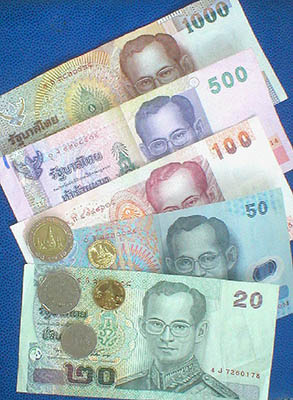
The baht is the official currency of Thailand. It can be divided into 100 satang. The issuance of currency is the responsibility of the Bank of Thailand. SWIFT ranked the Thai baht as the 10th-most-frequently used world payment currency as of December 2023.

The Chakri dynasty is the current reigning dynasty of the Kingdom of Thailand. The head of the house is the king, who is head of state. The family has ruled Thailand since the founding of the Rattanakosin Era and the city of Bangkok in 1782; following the end of Taksin Thonburi's reign, when the capital of Siam shifted to Bangkok. The royal house was founded by Rama I, an Ayutthaya military leader of Sino-Mon descent.

Bhumibol Adulyadej, conferred with the title King Bhumibol the Great, was the ninth King of Thailand from the Chakri dynasty, titled Rama IX. Reigning from 1946 until his death in 2016, he is the third-longest verified reigning sovereign monarch in world history after King Louis XIV and Queen Elizabeth II, reigning for 70 years and 126 days. His reign of over 70 years is the longest reign of any Thai monarch, and the longest rule of an independent Asian sovereign.

Ubol Ratana is a member of the Thai royal family. She is the eldest child of King Bhumibol Adulyadej and Queen Sirikit and elder sister of King Vajiralongkorn.

Vajiralongkorn is King of Thailand.

Princess Srinagarindra born Sangwan Talapat was a member of the Royal Thai Family. She was part of the House of Mahidol, which is descended from the Chakri Dynasty and was originated by Prince Mahidol Adulyadej. She was the mother of Princess Galyani Vadhana, the Princess of Naradhiwas, King Ananda Mahidol, and King Bhumibol Adulyadej and was the paternal grandmother of King Vajiralongkorn.
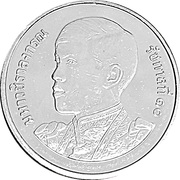
The one-baht coin is a denomination coin of the Thai baht, the Thai currency unit.
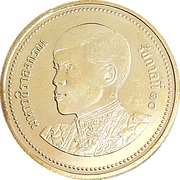
In Thailand, the two-baht coin is the coin which is worth 2 baht or 200 satang. The new 2-baht coin design features H.M. King Bhumibol Adulyadej, the Great on the obverse, like all other Thai legal tender coins presently in circulation. The reverse design depicts the Golden Mountain at Wat Saket Ratcha Wora Maha Wihan in Bangkok.
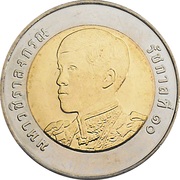
The bi-metallic Thailand ten-baht coin is a denomination coin of the Thai baht, the currency unit of Thailand.

Wat Chetawan is a Thai temple in Petaling District, Selangor, Malaysia. The temple is situated at Jalan Pantai, off Jalan Gasing in Petaling Jaya. It was built in 1957 and officiated by the late King Bhumibol Adulyadej, the King of Thailand at the time. The temple is also the only Malaysian Siamese temple which has been chosen as the custodian of the Buddha sacred relics for all Malaysian Buddhists that are parts of the ancient relics discovered in Piprahwa, a village in Uttar Pradesh near the border of the Kingdom of Nepal in 1898 which were presented to King Chulalongkorn of Siam by the then British Viceroy of India, Lord Curzon.
State decorations awarded by Thai King take the form of orders and medals. This page lists them by order of precedence.

The royal flags of Thailand are personal royal flags that are usually flown in Thailand, along with the national flag, to honor the King and royal family. Unlike the royal standards displayed only in special ceremonies and in particular locations, the royal flags are seen throughout Thailand. They are not commonly seen outside the country.
The history of Thai money used as a medium of exchange and to settle accounts before the adoption of Thai baht coins and banknotes include novel designs and forms. For Thai people, money was considered as the symbol of civilization. Currency itself reflected faith in religion, culture, the customs and traditions of each era and also serve as a record of the development of Thailand.

The Siam Society Under Royal Patronage was established in 1904 with a mission to promote knowledge of the culture, history, arts, and natural sciences of Thailand as well as those of neighbouring countries. The premises of the Society in Bangkok, Thailand on Asok Montri Road include a library with many rare books and the Kamthieng House Museum in a historic teak house. The Society has a regular programme of lectures, study trips, cultural events, and music performances. The Society publishes two scholarly journals, the Journal of the Siam Society and the Natural History Bulletin of the Siam Society, and several books. The Society is involved in preservation of heritage through the Siamese Heritage Trust. The membership includes people of around 60 nationalities.
The year 1995 was the 214th year of the Rattanakosin Kingdom of Thailand. It was the 50th year of the reign of King Bhumibol Adulyadej and is reckoned as the year 2538 in the Buddhist Era.
The Chakri Naruebodindra Medical Institute (CNMI) (Thai: สถาบันการแพทย์จักรีนฤบดินทร์) is a medical institute of the Faculty of Medicine Ramathibodi Hospital, Mahidol University in Thailand. In addition to providing medical services to the general public, it is also one of the two main facilities for training students of the faculty.
Sa Pathum Palace is a royal residence in Pathum Wan District, Bangkok, Thailand. It has been a residence of the Thai Royal Family, especially the House of Mahidol, since the 19th century, and is the official residence of Princess Sirindhorn.
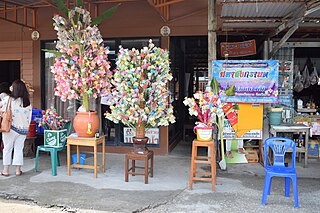
The banknotes of the Thai baht are part of the physical form of the Thai baht, Thailand's currency. The issuance of the baht banknotes is managed by the Bank of Thailand. Throughout its history, the denominations have ranged from 1 baht to 1,000 baht. The circulating banknotes today in Thailand, however, are ranged from 20 baht, 50 baht, 100 baht, 500 baht and 1000 baht. The currently circulating series are 17th, 16th and 15th series. Thai baht banknotes commonly include the portrait or the picture of the sculpture of its kings. The obverses have been designed with the current king's portrait. Whilst, in the reverses, mostly the picture of notable kings and kings with the title "the great". Some reverses feature the King Bhumibol's sayings.

Wat Yansangwararam Woramahawihan or Wat Yan is located in Huai Yai in the Chonburi province of Thailand. It is a large Buddhist temple complex with gardens and lakes and has been under the patronage of Bhumibol Adulyadej. Most of the buildings at Wat Yansangwararam were erected in honor of the Thai Royal Family. The temple is a replica of the Mahabodhi Temple in Bodh Gaya, Bihar, India.

















